 |
| Old wars: Weapons dating from the Dong Son Culture found at the site. Photo courtesy of Lam My Dung |
Viet Nam News
By Minh Thu
Archaeologist Lam My Dung, 59, and her students were digging at the Vuon Chuoi archaeological relic in Hoai Duc District on the outskirts of Ha Noi in 2011. The site had been discovered in 1969, but during the hard conditions of wartime, scientists lacked the resources to do further research on it.
Like all archaeologists, they faced the daunting prospect of difficult and meticulous labour with no guaranteed reward—they could make a critical find, or discover nothing at all. They didn’t know they would uncover one of the most significant archaeological finds in recent Vietnamese history: traces of burned rice and firewood.
The finding proved the first residents of the Red River Delta had settled here more than 3,500 years ago. The Vuon Chuoi relic contains artefacts belonging to different cultural layers.
But the archaeologists were dismayed to discover that the entire site belongs to the Thang Long 9 Construction Company, which has invested in an urban building project here. Buildings will soon mushroom here and the archaeological treasures will be buried forever.
Invaluable archaeological site
The 3,500-year-old archeological site is invaluable evidence of the Vietnamese people’s native origin, Dung has affirmed many times in scientific reports and at conferences.
Vuon Chuoi was first discovered in 1969 by the Viet Nam Archaeological Institute and has to date undergone eight excavations.
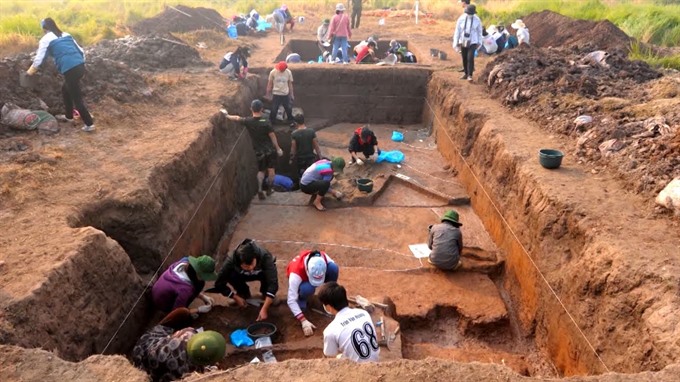 |
| Tough job: Archaeologists work on the excavation at the Vuon Chuoi archaeological site. Photos courtesy of Nguyen Van Huy |
During the course of excavations, archeologists have discovered 29 prehistoric tombs, nearly 150,000 pieces of pottery, 50 pottery artefacts, over 200 bronze artefacts, 11 iron artefacts, and 1,000 wooden artefacts.
Through thousands of years, the archeological site has preserved age-old artefacts representing diverse cultural periods, such as the Dong Dau Culture (1,500-1,000 BC), the Go Mun (1,000-600 BC) and the Dong Son (700 BC - AD 100).
Dung said there is a metre-thick layer across the site that contains artefacts offering insight into the lives of ancient people.
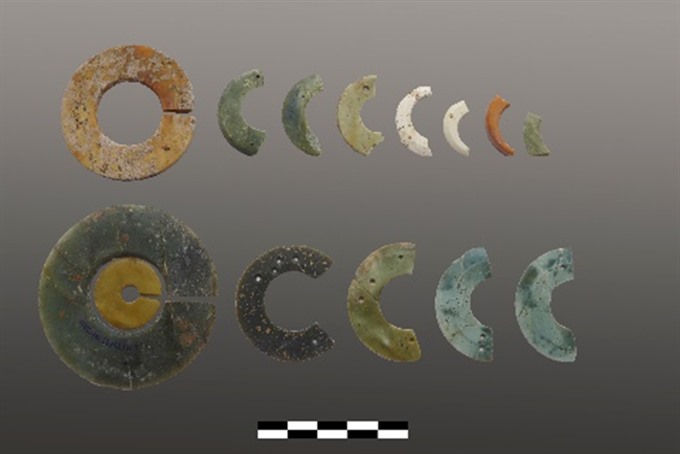 |
| Jewels: Earings made from nephrite stone found at the site. |
These deposits could be dated to the middle phase of the Bronze Age, coinciding with the Dong Dau Culture.
“The cultural layer is intact. We have discovered various vestiges of human life, such as fire-places, kilns for bronze casting, rubbish pits, pits for clay exploitation and holes with small diameters like pits of house bamboo or wooden columns.”
“The assemblage consists of stone tools such as axe, chisel, stone ornaments such as earrings, bracelet, beads… the pottery is also rich in form and decoration and is typical for the Dong Dau Culture,” she said. “There were uncovered some human skull fragments in Dong Dau cultural layers, but the excavators could not find the vestiges of any grave structure.”
“It is important to note that the results of the latest excavation in 2014 at Vuon Chuoi site have contributed considerably to understanding the development of bronze working of people during the Dong Dau period,” Dung continued.
Besides the Dong Dau cultural features and artefacts, two graves dating to the Dong Son period were uncovered. One contained some grave goods, including bronze arrows, bronze axe and pottery pots. The other does not have grave goods.
“Such evidence is extremely rare for any capital city in the world,” said ethnological expert Nguyen Van Huy.
“The site also proves the native origin of the Vietnamese people and outlines their history during the prehistoric and protohistoric periods.”
Huy stressed that this is the only place in Ha Noi where specialists have found artefacts of the prehistoric age in a large density.
Risk of being wiped out
One day in 2011, archaeologist Dung received a phone call from local residents. They said that many steam-shovels and bulldozers were smoothing the surface of the site. Construction workers carelessly dug out artefacts and the people rushed to collect them.
The scientists hurried to the site. They panicked as they faced the bulldozers rapidly churning the earth.
Huy raised his voice, asking the city government to take urgent measures to protect the threatened archeological site. He sent letters to the city’s authorities in an effort to call for the conservation of the site.
Huy highlighted the importance of Vuon Chuoi as the site is considered as the first site of human settlement of ancient Vietnamese people and serves as obvious evidence of the native origins of the Vietnamese in the capital city.
“Yet the site is still not officially listed as a conservation area by the State, so it’s hard to protect the artefacts,” he said.
Because it lacks conservation status, the Thang Long 9 Construction Company was permitted to include the entirety of the 19,000sq.m site in its project plans.
“Without due action from authorities to protect this archeological site and its significance to Ha Noi, Vuon Chuoi and other nearby sites will soon be wiped from existence,” Huy warned.
Vietnamese archeologists are calling on the public to help save the site and support them to continue researching.
Making matters more complicated, it was not Ha Noi’s government that approved the project, but rather the leaders of the former Ha Tay Province, which was subsumed into the city in 2008, Truong Minh Tien, deputy director of the municipal Department of Culture and Sports, told the newspaper Tuoi Tre.
Currently, Tien’s department asked to pause the project. However, the fact that the infrastructure construction such as building roads and drainage harmed the relic site seriously.
Save it from the brink of disappearance
Archaeologist Tong Trung Tin, director of the Viet Nam Archaeology Institute, said the authorities should take urgent actions to protect the site.
“This is the treasurous vestige of the capital,” he said.
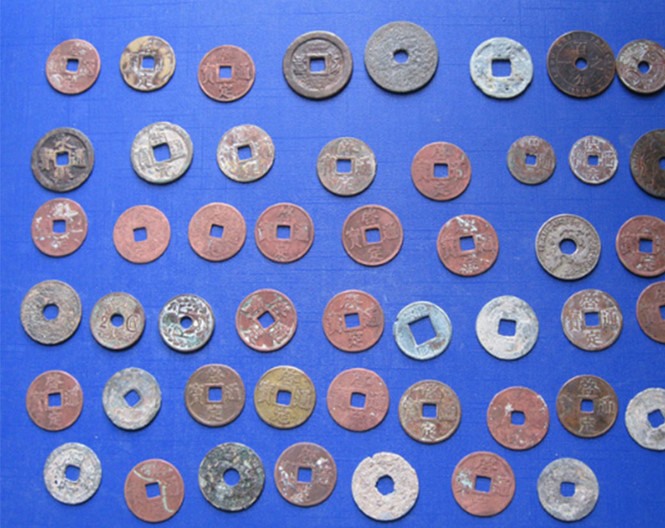 |
| Get money: Coins found at the site. |
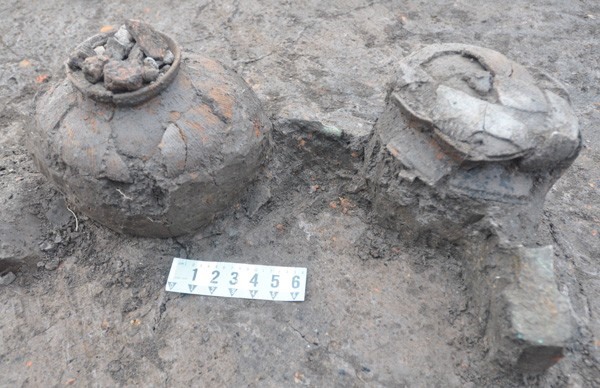 |
| Ancient pot: A jar dating from 3,000 years ago. |
 |
| Remains: A skeleton found at the site. Photo courtesy of Lam My Dung |
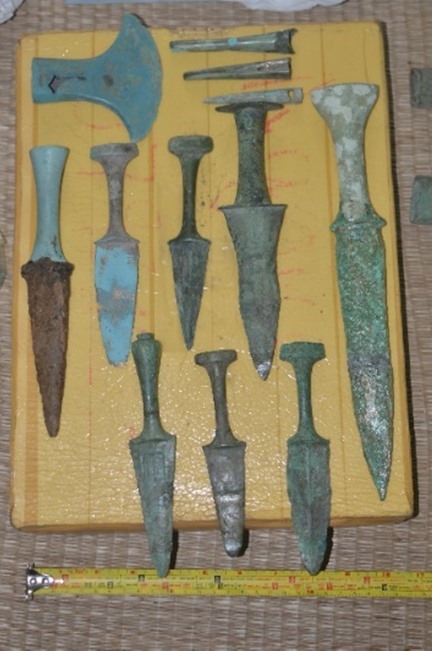 |
| Long ago: Weapons dating from the Dong Son Culture found at the site. Photo courtesy of Lam My Dung |
Tin said it’s necessary to complete a dossier to submit to the State to recognise the site as the important heritage. When the site is recognised, it will be protected carefully.
“The Vuon Chuoi archeological site must be included in Ha Noi’s overall archeological planning if it is to be listed for conservation. So far we have no draft of such a plan,” Tien of the municipal Department of Culture and Sports said.
Tien told Viet Nam News that the city leaders have acknowledged that the Vuon Chuoi archeological relic plays an important role in the history and culture of the city in particular and Viet Nam in general.
“We are calling on the experts including archaeologists Tin and Dung to make reports and suggestions to preserve the site,” he said.
“We have scheduled a conference in the middle of this year, where we will collect opinions from the experts and submit a report to the People’s Committee.”
“In the short term, we require the construction project to stop work on the site.”
However, Tien expressed concern that it’s necessary to balance the benefits of enterprise with the need to protect heritage.
“We really want to protect it, but we still care about the city’s development at the same time,” he said.
Archaeologist Dung said she recognises that the site can’t be kept intact completely.
“No buildings have been constructed so we can change the project planning,” she said.
“The project owners can work on the places where the excavations are finished and the artefacts are collected and preserved at the nearby museums, such as the Ha Noi Museum,” she suggested.
“For the places where excavations haven’t been done, the project owners can turn them to play-grounds, flower gardens and parking areas, not buildings.”
Villagers living near the site are proud to live in the land of heritage. They collect many artefacts and have stored them at the cultural house of Lai Xa Village, Kim Chung Commune.
However, they are just a small number of antiques compared with those which have been traded illegally without the management of the authorities.
Locals share experts’ concern that the site should be protected and its value presented to the public, as the earliest known Hanoians deserve to be in touch with their descendants. —VNS
OVietnam